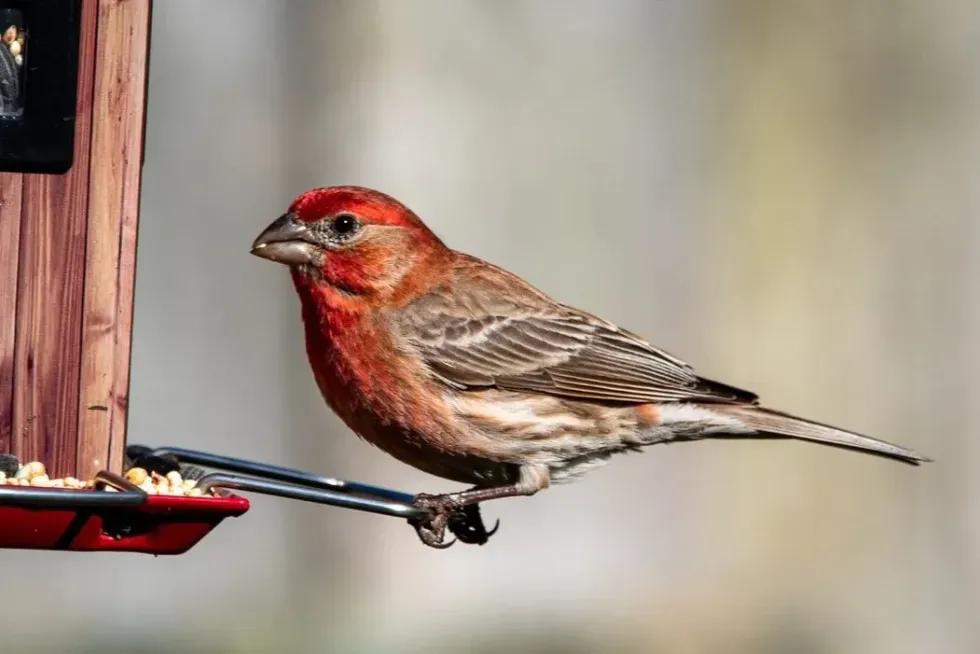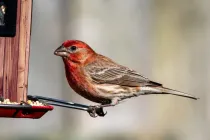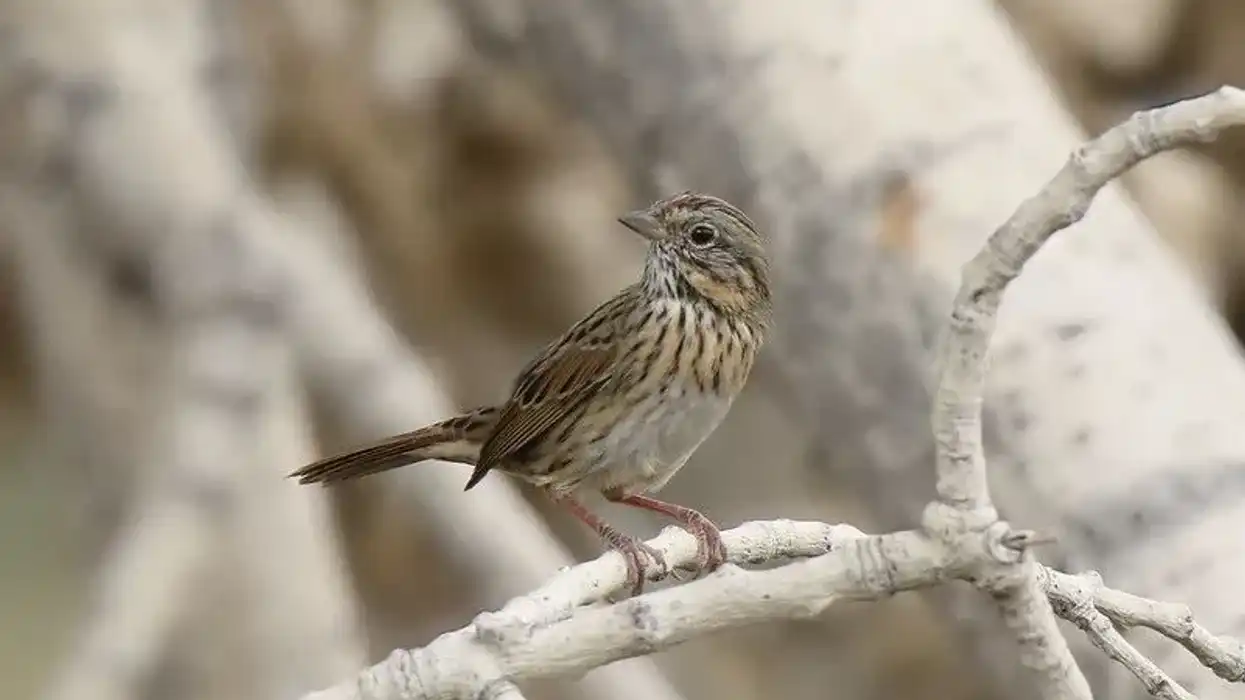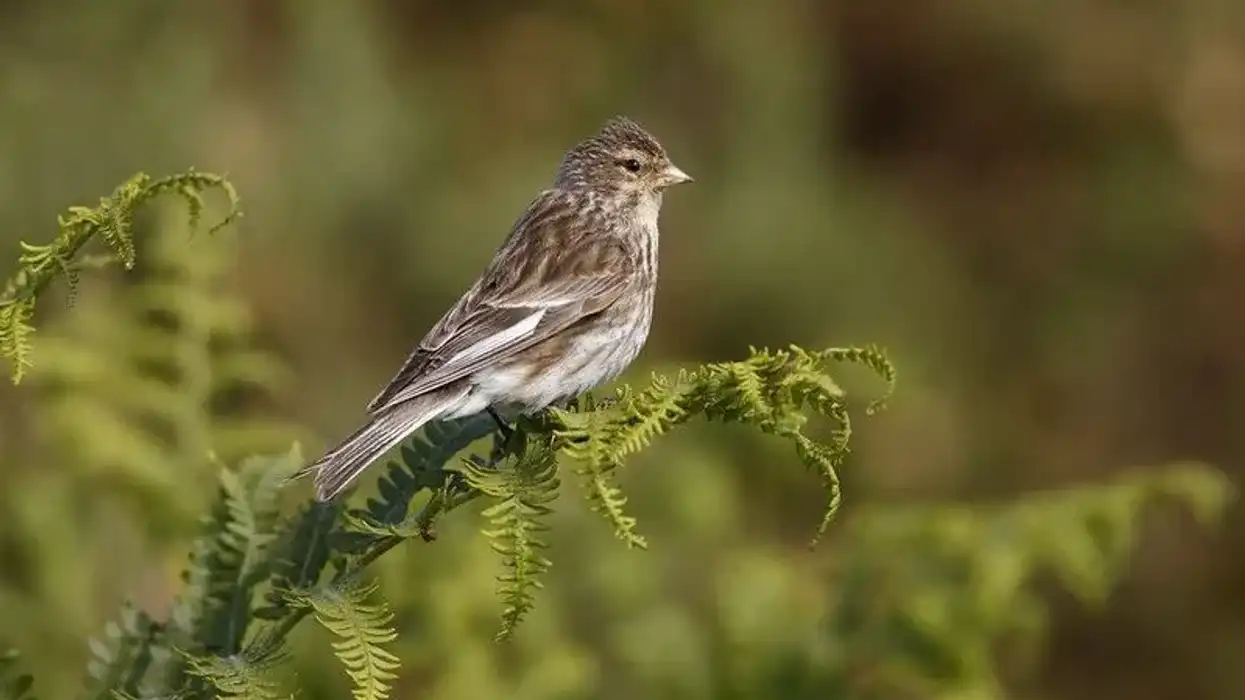The house finch (Haemorhous mexicanus) is one of the most common birds found across North American countries such as Mexico, the United States, and Canada. The genus Haemorhous has three species - the house finch, the purple finch, and the Cassin's finch.
The male house finches have red coloration on their body, which separates them from the females. These small birds are most common near urban and suburban dwellings.
In 1994, the scientists at Cornell Lab of Ornithology found a new disease spreading among many of these bird species. After extensive research carried out by the Cornell Lab of Ornithology for years, the scientists found that the red-headed finch developed immunity towards the disease automatically.
For more such interesting facts on the American red finch, red finch eggs, the red finch song, red finch nest, red finch vs. purple finch, and black and red finch, read the article below.
If you want to read more animal facts that your kids will enjoy, here are a few articles that you can check out the southern cassowary and the shoebill.
Red Finch Interesting Facts
What type of animal is a Red Finch?
The house finch is a very common bird seen near urban dwellings and suburbs in countries of North America such as the United States and Mexico. You can find house finches near human dwellings mostly.
What class of animal does a Red Finch belong to?
The house finch belongs to the Aves class of the Animalia kingdom.
How many Red Finchs are there in the world?
There are approximately 40 million to 1.7 billion house finches in the world.
Where does a Red Finch live?
The original habitat of the house finches was presumably woodland edges, chaparral, bushes, and trees along streams in dry country. But presently, they mostly inhabit urban and suburban areas, such as towns, cities, farmlands, or other places populated by humans.
They avoid grasslands and unbroken forests and are most commonly found in areas with buildings, trees, and lawns. In rural areas, you can find house finches in stables and barns.
What is a Red Finch's habitat?
House finches are found in countries of North America, particularly across the U.S.A, in Mexico, and in southern Canada. Though some eastern and northern populations migrate south in the winter, most of these birds are chiefly permanent residents throughout their range including several semi-open areas in the west, from the Mexican state of Oaxaca to southern Canada.
Who do Red Finches live with?
House finches are highly social birds and form flocks, consisting of even several hundred birds at times. They are rarely seen alone apart from the breeding season. These birds are seriously monogamous in nature and are even found to stay with the same partner throughout the year.
How long does a Red Finch live?
House finches have an average lifespan of up to 11 years.
How do they reproduce?
House finches are seriously monogamous in nature and are even found to stay with the same partner throughout the year. The male finches attract the female with the deep red pigmentations on their heads. The males also present the females with food bits and feed them if the females approve.
What is their conservation status?
Wikipedia sources state that the current population of house finches is approximately somewhere between 40 million to 1.7 billion individuals. Presently, there is no major threat to their existence and their population is increasing every day. Hence they have been classified as Least Concern (LC) on the IUCN Red List.
Red Finch Fun Facts
What does Red Finches look like?

The adult house finch has deep gray shading on its wings, a dullish brown color across its back, and a square-tipped, long, brown tail. There are streaks on the flanks, and sometimes on the breast and stomach too.
The head and breast of the adult male house finch are rosy red, and the color extends along the neck, shoulder, and sometimes down the back to the wings also.
Unlike the males, the adult female is not red in color. The upper part of its body, including the breast, is brown, and there are streaks on the underparts. It has brown streaks on its head, belly, back, and tail. The most common color of an adult female bird is plain grayish-brown.
How cute are they?
People usually welcome house finches - most likely because they are cute and friendly. The biology behind the bright red color of the males is fascinating.
How do they communicate?
The red finch birds utter a loud warbling tune before the sun sets and also just after the sun rises during the breeding season. This song becomes most intense during the breeding, nesting, and courtship periods. The plumage of the birds and their body posture are also important aspects of their communication.
How big is a Red Finch?
The house finch is a small bird with an average size of 4.9-5.9 in (12.5-15 cm) and has a wingspan of 8-10 in (20-25 cm).
How fast can a Red Finch fly?
There is no specific information available regarding the flying speed of a house finch.
How much does a Red Finch weigh?
A house finch has an average weight of 0.5-0.9 oz (16-27g).
What are their male and female names of the species?
There are no specific names for the male or female house finches.
What would you call a baby Red Finch?
There is no specific name for a baby house finch, it is called a chick like every other bird species.
What do they eat?
House finches are herbivores, mainly frugivores, and granivores, in nature. Their primary diet includes seeds such as mustard seeds, berries, buds, grains, fruits, and more.
They are voracious consumers of weed seeds such as dandelion and nettle, as well as of cactus, poison oak, thistle, knotweed, and many other species. In orchards, the house finch's diet includes various fruits such as peaches, strawberries, cherries, figs, pears, blackberries, apricots, and plums.
These birds are attracted to black sunflower seeds and at the bird feeder, house finches feed on black oil sunflower seeds over the millet, milo, and larger, striped sunflower seeds. House finches feed on small insects such as aphids.
Are they dangerous?
Finches do not attack humans. However, if they sense danger, they may show signs of aggression like biting other birds of their own species or by their plucking feathers. Still, they are unlikely to hurt humans.
Would they make a good pet?
Finches are sociable birds who are seldom seen alone apart from the breeding season. Hence, these birds are a good choice for pets as they are chirpy and lively. They love the company of cage mates and exhibit playful behavior. However, they are mostly hands-off pet birds and prefer to be with other of their kind.
Did you know...
The male house finch derives its red coloration from the colored pigments in its food during molt. The birds are not able to procure yellow or red colors directly, and thus, the red color of these bird species is directly reliant on their food. This is why you can spot orange or even yellow finches.
The house finch was originally a native of Mexico and the western United States and Mexico. It was by pure accident that they turned up in Long Island, New York after failed attempts were made to sell them as 'Hollywood finches' in 1940.
Their population increased exponentially as the species started to breed rapidly. By the turn of the millennium, the bird species had spread across almost all of southern Canada and the eastern United States.
What is the symbolism of a Red Finch?
Finches symbolize positive energy and better things to come in life. It also denotes happiness. Seeing a house finch means good things are in store for you in the foreseeable future. Having the finch as your spirit animal states that you are dedicated enough to complete your goals and are also strong.
Dreaming about house finches is symbolic of your hopes, goals, and aspirations coming to life. It means you are presently undergoing pleasure, love, and harmony in your life.
Purple Finch vs. House Finch
Identifying the house finch and the purple finch can pose a challenge to even the most experienced bird explorers. Here are a few points of difference between the two birds -
The purple finch is slightly larger in size compared to the house finch. The former has a larger head and thicker neck in proportion to its body size.
Both the male species of the purple and house finches are red and brown in color. But they can be differentiated easily from the different shades of red. House finches are mostly colored like a ripe strawberry (red-orange or classic red). Purple finches have the same hue as a raspberry (rosy or dark pink).
The red color of the male house finch is confined to some body parts such as the brow, upper chest, and forehead. The males of the purple finch species have more extensive red coloring on their bodies.
The purple finch has a relatively shorter tail compared to house finches but possesses a much more distinct notch than the red-breasted finch on their tail.
Here at Kidadl, we have carefully created lots of interesting family-friendly animal facts for everyone to discover! Learn more about some other birds including the chinstrap penguin and the frigate bird.
You can even occupy yourself at home by drawing one on our Red finch coloring pages.










